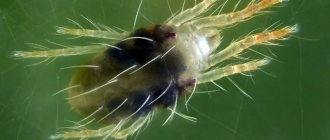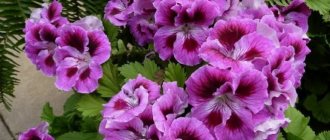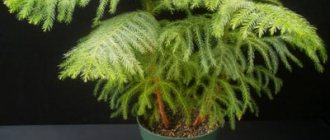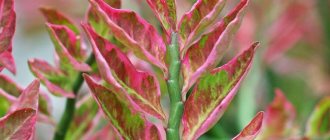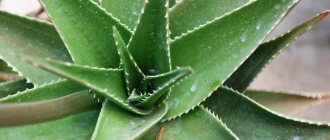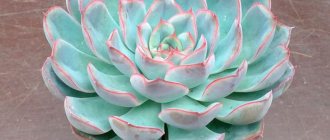Many people don’t even know what a dizygoteca flower looks like. However, this is a very amazing and original plant. Many gardeners ignore it due to its “capricious disposition” when growing. But if you adapt and fulfill all the requirements, you can grow a very cute and beautiful tree native to tropical countries, which will certainly decorate your home.
What does dizygoteca look like?
This plant belongs to the category of evergreen shrubs and trees of the Araliaceae family. It’s beautiful enough that photos of dizygotheca always turn out successful and aesthetically pleasing.
In appearance, it is a bit reminiscent of a palm tree - the smooth trunk is decorated with a spreading crown with a diameter sometimes reaching 4 meters. The height of dizygotheca when growing in natural climatic conditions is from 6 to 8 meters, but when grown indoors it is limited to two meters. As its age increases, the straight trunk of the plant begins to harden and become covered with denser bark.
The leaves of Dizygotheca are very beautiful - large and palmate, separated into 7-10 lobes. The length of one lobe can be from 10 to 30 centimeters, the edges are jagged, the lobes are united by a petiole, up to 40 cm long.
The foliage can be painted in various dark colors, such as dark red, green, and almost black shades. On the dark background of the leaf, lighter veins are visible, the same color as the petioles.
How does dizygoteca bloom? Very modest, its inflorescences are umbrella-type, very small, and therefore are not always valued as a decorative decoration.
Main types
Within the group, several varieties of dizygotheca can be distinguished:
- elegant.
The low tree reaches 2 m in height. It is also distinguished by 30 cm leaves on long petioles with serrated leaf blades. Within this species, there are 3 varieties: desigoteca Bianca, Castor, Gemini; - Veitch. This variety is very similar to the previous one. The main difference is wider, but at the same time short oval leaves;
- Kerkhova. Dizygoteca has all the features of Veichi, but its leaves have a different shape and are colored a little lighter;
- Gracillima. The lowest among relatives; The edges of the wide leaves are wavy, the color is pale.
Did you know? Dizygotheca can hardly be called a popular plant, but it has more famous relatives (for example, ginseng).
The dizygotheca plant is represented by different varieties. Each of them has its own characteristics. There are more than 100 species in nature, but only some of them are adapted to home conditions.
In the right conditions, the tree can grow up to 150 cm
It blooms rarely, the inflorescences are collected in umbrellas, which are white in color. They look inconspicuous and unnoticeable.
Dizygoteca Bianca
The leaves are dark green with purple veins. The edges are adorned with an irregular cream-colored edge. All this gives the plant a variegated appearance. The leaf blade rarely exceeds 9 cm in length and 1.5 cm in width. The edges are jagged with slightly smoothed apices.
Dizygoteca graceful
Grows up to 2 m in height. The leaves are long, narrow, collected in umbrellas of 11 pieces. It branches poorly, usually most of the leaves are at the top of the tree.
Other types and varieties
The Zhemani variety is distinguished by wide leaves up to 3-4 cm, and the length of the plate reaches up to 5 cm. The central vein is reddish, the cloves are of the same shade.
Dizygoteca Veyche is distinguished by smooth edges of leaves that grow up to 4 cm wide. The description of the Kerkhova variety is no different from Veyche, only this species has a paler color.
How to properly care
Despite the fact that the plant comes from the tropics, it still prefers to grow in the shade of other trees that are taller than itself. For good growth, the growing conditions in the room must match those in nature.
Caring for dizygoteca at home involves strict adherence to criteria such as proper light, watering, humidity, etc.
Brief description of cultivation
- Temperature regime . In summer, the optimal air temperature is 18–25 degrees, and in winter – at least 16 degrees. Protect the flower from sudden changes in temperature, as they can cause the leaves to die and fly away.
- Air humidity . The plant needs high air humidity. To do this, install a household humidifier in the room or regularly moisten the bush with a sprayer 2 times a day.
- Illumination . A large amount of diffused light is required for at least 10 hours a day. Make sure that the foliage is not exposed to direct sunlight, as this can cause burns.
- Watering . In summer, the soil mixture in the pot is moistened moderately once every four days; in the winter months, the plant is watered once every one and a half weeks. If the soil mixture does not dry well during this time, then the number of waterings is reduced to once every 2 weeks. The water should be soft.
- Soil mixture . It should be light and consist of river sand (perlite), peat and expanded clay. The substrate must be well drained.
- Fertilizer . In order for dizygoteca to grow and develop normally, it needs organic matter and mineral fertilizers, which are applied alternately. Feeding is carried out in March–October 2 times a month.
- Transplant . A young bush should be replanted annually at the beginning of spring. A bush older than three years is replanted only if necessary, for example, when the roots become cramped in the pot.
- Reproduction . The seed method (rarely) and cuttings are used. Cuttings are harvested in spring, and their minimum length is 80 mm. Dip the cut area in a root growth stimulating agent, plant it for rooting in moistened sand or perlite, and place it in a greenhouse (optimal temperature is about 23 degrees). Roots will appear after about 20 days.
- Features of care . At first, it is important to ensure that the plant is comfortable in the conditions you create. If the bush grows normally and looks healthy, then you are doing everything right.
Indoor plants / Dizygoteka
Lighting
The most optimal solution would be to place the dizygoteca tree on the eastern side of the room. There is enough light and no hot afternoon sun.
It is important to maintain consistency in the position of the plant relative to the light source: you cannot turn or move it, as this may cause the tree to shed its leaves.
In winter, it is important to provide 10-12 hours of daylight. For this, you can use phytolamps or fluorescent lamps.
Air temperature and ventilation
In the room where the dizygotheca flower will grow, it is necessary to maintain the air temperature no lower than 18 degrees Celsius (otherwise the plant will shed its leaves) and no higher than 29 degrees (otherwise the plant will “burn” from the heat).
This plant loves fresh air, but despite this, it is afraid of drafts and sudden changes in temperature. In this regard, when ventilating a room in the cold season, it is important to ensure that the flower does not fall under direct air currents.
Watering
This plant needs balanced watering - in hot and warm periods, abundant and regular watering is important, in the cold season it needs to be watered more moderately. If there is a lack of moisture in dizygotheca, the leaves begin to dry out; if there is too much moisture, the soil may become acidic, as a result of which fungus and other diseases develop.
To determine whether a plant needs watering, you can touch the top layer of soil. If it's dry, then it's time to water it. By the way, for this it is better to use soft water that has settled for several days at room temperature.
Further transfers
In the future, it is recommended to replant after 2-3 years in the spring. In this case, it is necessary to completely replace the soil. For young plants, you need to select a pot with a slight increase in size; adults can be planted again in the same container, replacing the soil mixture. During transplantation, roots should be handled with extreme care so as not to injure them. You should remove old soil from them not with your hands, but with a warm stream of water. For old plants, the soil does not need to be completely renewed, limiting itself to replacing the top layer.
For reliability, it is recommended to place a weighting agent at the bottom of the pot so that the upper part does not weigh down. It will also serve as a good drainage material.
To make the plant more decorative, it is better to plant 2 or 3 specimens in one container.
Crown formation
To form an aesthetic crown in dizygotheca, it must be properly trimmed. If this is not done, as the plant grows, it will shed its lower leaves (which is the norm here), and eventually a straight and bare trunk will grow with leaves at the top.
Pinching the tops won't help here. To do this, the plant is radically pruned in March. The best pruning option is when you leave a very short stump of about 15 cm. New buds will begin to form and new branches will appear at the base of the trunk.
Diseases and pests
The plant is quite resistant to diseases, but sometimes pests such as aphids, mealybugs, whiteflies, and spider mites appear on it.
For preventative purposes, you can periodically treat the leaves with a cotton pad soaked in a weak soap solution. And once pests are identified, the plant needs to be treated with chamomile infusion. If such an infusion does not cope with the problem, then insecticides can be used (but with caution).
Possible problems
You should not expect trouble-free cultivation of dizygoteca: all proper conditions must be strictly observed. If they are violated, problems with the leaves may occur:
- falling off - from violation of the watering schedule, strong drafts, frequent rearrangement of the pot;
- drying or brittleness - from excessive dryness of air and soil;
- wilting - due to excessive heat;
- darkening of the cover - both overmoistening of the soil and its salinity may be to blame;
- yellowing of the edges - a combination of dry air and waterlogged soil;
- white coating - use of hard water.
If there is a lack of light or the planting container is too spacious, growth may slow down (the norm is at least 30 cm per year). Insects harm dizygotheca very rarely; spider mites, aphids, scale insects and mealybugs are dangerous. To destroy them, you can safely use insecticides and acaricides.
Dizygoteca is an interesting indoor plant that requires creating high air humidity and maintaining a constant temperature. Unfortunately, once you have it in your apartment, you cannot be away for more than a couple of days: it requires almost daily care.
How does dizygotheca reproduce?
This type of plant propagates by seeds or stem cuttings.
Muraya: types, description, care and cultivation at home. 140 photos and video instructions for maintaining a bushTea tree: growing at home. Indications and contraindications for the use of medicinal plants (115 photos + video)
Clerodendrum: proper care at home and the nuances of maintaining a shrub (130 photos + video)
Seeds are planted in moist soil. To do this, simply distribute them over the surface of the soil without deepening them, spray them with water, and cover them with film. After the formation of two true leaves, new plants are planted in suitable pots.
For propagation by cuttings, they are cut approximately 10 cm long so that each has 3-4 leaves. Be sure to treat with a growth stimulator and only then plant in a peat-sand mixture.
After planting, the cuttings are also covered with film. We must not forget about their moderate watering. The young shoot is transplanted after about a couple of months.
Reproduction
Both seed propagation and planting of cuttings are used. Of course, the second method is easier. Cuttings about 10 cm long are cut from the tips of the shoots in the spring with a clean knife, making oblique cuts. After drying a little, they are treated with a root formation stimulator and planted in a mixture of damp moss, sand and perlite. Covering with a plastic bag, wait for the roots to appear, which is usually observed at room temperature after 20-25 days.
If you purchase high-quality seeds, you can grow seedlings from them, but it is extremely rare to obtain seeds from your own plant. Sowing is carried out in a moist substrate at a minimum depth, creating greenhouse conditions and a temperature of about 27 degrees. Seed germination is low, but seedlings appear within a week. Their care is usual; the seedlings grow very slowly at first.

